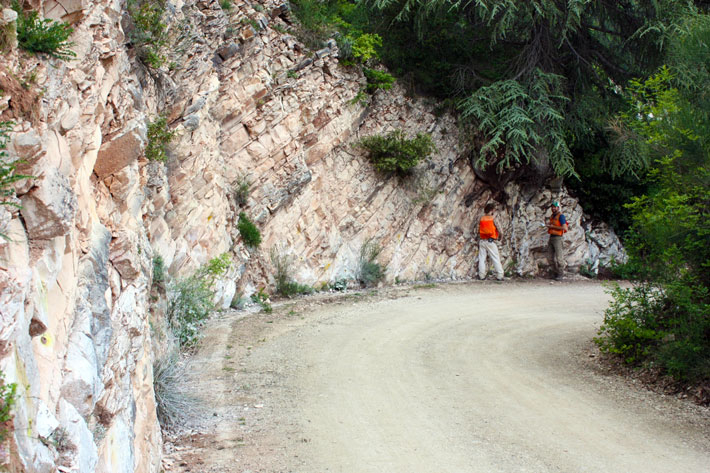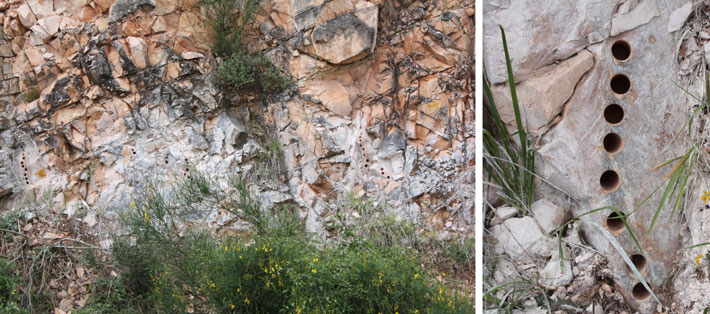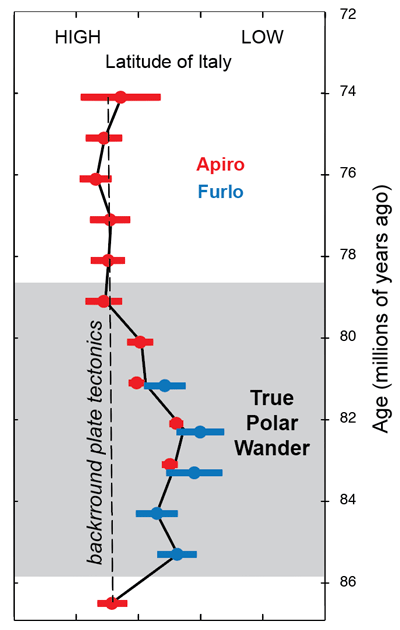Hold on to your hats, because scientists have found more evidence that Earth tips over from time to time. We know that the continents are moving slowly due to plate tectonics, but continental drift only pushes the tectonic plates past each other. It has been debated for the past few decades whether the outer, solid shell of the Earth can wobble about, or even tip over relative to the spin axis. Such a shift of Earth is called "true polar wander", but the evidence for this process has been contentious. New research published in Nature Communications, led by the Earth-Life Science Institute (ELSI) at Tokyo Institute of Technology's Principle Investigator Joe Kirschvink (also a Professor at Caltech) and Prof. Ross Mitchell at the Institute of Geology and Geophysics in Beijing, provides some of the most convincing evidence to date that such planetary tipping has indeed occurred in Earth's past.
True polar wander bears some dissecting. The Earth is a stratified ball, with a solid metal inner core, a liquid metal outer core, and a solid mantle and overriding crust at the surface which we live on. All of this is spinning like a top, once per day. Because the Earth's outer core is liquid, the solid mantle and crust are able to slide around on top of it. Relatively dense structures, such as subducting oceanic plates and massive volcanoes like Hawaii, prefer to be near the Equator, in the same way that your arms like to be out to your side when you are spinning around in an office chair.
Despite this wandering of the crust, Earth' magnetic field is generated by electrical currents in the convecting liquid Ni-Fe metal of the outer core. On long time scales, the overlying wander of the mantle and crust does not affect the core, because those overlying rock layers are transparent to Earth's magnetic field. In contrast, the convection patterns in this outer core are actually forced to dance around Earth's rotation axis, which means that the overall pattern of Earth's magnetic field is predictable, spreading out in the same fashion as iron filings lining up over a small bar magnet. Hence, these data provide excellent information about the direction of the North and South geographic poles, and the tilt gives the distance from the poles (a vertical field means you are at the pole, horizontal tells us it was on the Equator). Many rocks actually record the direction of the local magnetic field as they form, in much the same way that a magnetic tape records your music. For example, tiny crystals of the mineral magnetite produced by some bacteria actually line up like tiny compass needles, and get trapped in the sediments when the rock solidifies. This, "fossil" magnetism can be used to track where the spin axis is wandering relative to the crust.
"Imagine looking at Earth from space," explains Kirschvink "True polar wander would look like the Earth tipping on its side, and what's actually happening is that the whole rocky shell of the planet—the solid mantle and crust—is rotating around the liquid outer core." Although scientists can measure true polar wander occurring today very precisely with satellites, geologists still debate whether large rotations of the mantle and crust have occurred in Earth's past.
One particularly heated debate has been over events during the Late Cretaceous, about 84 million years ago. Over the last three decades, geophysicists have been going back and forth through public arguments in the journal Science, and at numerous meetings, about whether a large true polar wander event occurred in the Cretaceous.
Mitchell and Kirschvink came up with a plan for settling the debate once and for all. Leveraging Mitchell's experience as a student studying the geology of the Apennine Mountains of central Italy, he knew just the right rocks to sample. The international team of researchers then placed their bet that paleomagnetic data from limestones created in the Cretaceous (between ~145.5 and 65.5 million years ago) located in Italy would provide a definitive test. The magnetism of the younger rocks in the same area was studied nearly 50 years ago, and indirectly led to the discovery of the asteroid impact that killed the dinosaurs. Sarah Slotznick, co-author and geobiologist at Dartmouth College explains, "these Italian sedimentary rocks turn out to be special and very reliable because the magnetic minerals are actually fossils of bacteria that formed chains of the mineral magnetite."
To test their hypothesis about true polar wander, paleomagnetic data with lots of redundancy are required to track the wander of the ancient location of Earth's spin axis. Prior studies, especially some claiming that true polar wander does not occur, have failed to explore enough data points according to the team. Says Richard Gordon, a geophysicist at Rice University in Houston who wasn't involved in the study, "that is one reason why it is so refreshing to see this study with its abundant and beautiful paleomagnetic data."
Kirschvink and colleagues found, as the true polar wander hypothesis predicted, the Italian data indicate an ~12˚ tilt of the planet 84 million years ago. The team also found that Earth appears to have corrected itself—after tipping on its side, Earth reversed course and rotated right back, for a total excursion of nearly 25˚ of arc in about five million years. Certainly, this was a cosmic "yo-yo".
. Any information published on this site will be valid in relation to Science Tokyo.





